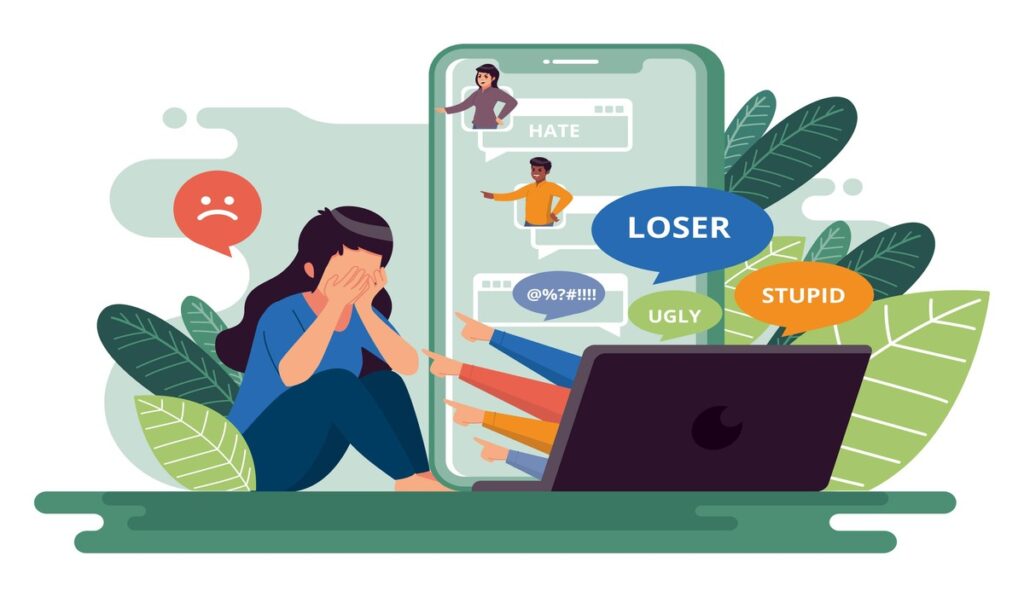
What is Cyberbullying, and why is it harmful?
Cyberbullying is an act in which someone intentionally uploads negative photos, data, or rumours about another person through live streams, private messages, and comments to hurt somebody’s emotions and hurt them emotionally.
Cyberbullying on TikTok can disrupt someone’s mind. It causes anxiety. It leads to depression and sometimes even brings thoughts of suicide. On TikTok, things spread fast, and people can stay anonymous, which worsens the problem. That is why parents must be aware and take action.
Read below for the effects, types of harassment, and prevention techniques to protect your child from cyberbullying on TikTok.
The Psychological Effects of TikTok
TikTok is super popular because it’s short, fun videos that are easy to watch. But because everyone’s trying to get likes and comments, it can turn into a competition, especially for teens. They feel a lot of pressure to look good and get approval. It can make them anxious. It can hurt their self-esteem. This constant need for validation makes them more likely to be affected by cyberbullying. So, while TikTok can be a lot of fun, it can also cause stress—and emotional pain if people aren’t careful.
Types of Online Harassment on TikTok
1. Defamation
Defamation means spreading untrue information or rumours to harm another person’s reputation. On TikTok, this may happen in various forms, including posting false ads or negative comments about someone. Because TikTok allows content to spread quickly and widely, the damage from defamation can escalate rapidly, affecting the victim’s life online and offline.
2. Trolling
Trolling involves intentionally posting offensive or provocative content online to upset people or cause disruptions. On TikTok, trolls leave harsh comments on posts to provoke anger and frustration and to get strong emotional reactions from the creators. As they enjoy the conflict they create. This trolling can make the TikTok experience stressful for creators.

3. Online Impersonation
Online Impersonation happens when someone creates a fake profile pretending to be someone else. With counterfeit accounts, impersonators post mean stuff or spread rumours, causing trouble for creators. It destroys the victim’s online reputation and affects their image, causing stress.
4. Hate Speech
Hate speech is the use of abusive words, images, or videos that insult a person based on their religion, race, sexual orientation, gender, or other personal characteristics. On TikTok, this could be seen as harsh comments, offensive jokes, or hurtful stereotypes targeting specific communities.
5. Spreading False Rumour
Spreading false rumours means sharing stuff that isn’t true or hasn’t been checked to hurt someone’s reputation or mess with their mental health. On TikTok, this can happen through videos, comments, or direct messages where people spread lies about someone. These false rumours can spread fast, and other people might also start believing and sharing the lies. It can harm the person being targeted, causing them a lot of stress and anxiety.
6. Sending Explicit Images and Messages
It includes sending sexual photos, videos, or texts to someone who didn’t ask for or wish to receive them. Receiving such undesirable messages can be highly unpleasant. It can make the person feel embarrassed and scared, leading to anxiety, depression, and a loss of trust in social media. This harassment affects their mental health and personal relationships.
How Does Cyberbullying Manifest on TikTok?
1. Recognizing Harmful Content
Recognizing dangerous content on TikTok is essential for your child child’s well-being. Harmful content can include negative comments—hurtful videos or malicious duets where users add offensive commentary. Parents should watch for signs of distress, such as mood changes or withdrawal. They should familiarize themselves with the content their child engages with. It means watching the videos their child creates and views, reading comments, and observing any duets or collaborations. By staying informed and involved, parents can identify harmful content. They can address it by discussing it with their child. Additionally, they can report offensive material and use TikTok’s safety features to block problematic users.
2. Understanding the Anonymity Factor
Understanding how secrecy works on TikTok is essential for understanding why cyber bullying is increasing there. Users feel braver when they can stay anonymous or use fictitious names. They make hurtful comments and act mean. They’re not worried about getting caught. For the victims, this can be extremely difficult because they usually have no idea who is harming them, which makes them feel even lonelier.
Parents must monitor their children’s children’s TikTok activities and understand how security works on the platform. Talk to your children about potential risks and tell them they may come to you if something terrible happens.

3. The Pressure to Perform and Go Viral
The impulse to create viral content on TikTok can be highly challenging for children and teenagers. The platform’s emphasis on views and likes pushes them to develop new and compelling posts. It can lead to risky or attention-grabbing behaviour, such as doing dangerous stunts or disclosing sensitive information, to get spotted. This pressure can make children more open to social media cyberbullying. When their videos fail to succeed well or receive unfavourable responses, they may feel unacceptable and insecure, forcing them to consider serious steps. Running for likes and views can cause anxiety, sadness, or a sense of rejection.
Parents should communicate with their children about creating content for entertainment, not only for approval, and to help them have the right balance with social media.
Keeping Your Child Safe on TikTok
1. Privacy Settings and Account Management
Parents must check that their children’s TikTok accounts are set to private. This setting limits who can see and use their information and greatly minimizes exposure to potential abusers and unwanted attention. Parents should also regularly review and update their privacy settings to stay up-to-date on any changes TikTok might introduce. It includes checking who can send direct messages, comment on videos, and view their child’s profile. By keeping these settings tight, parents can offer additional protection. It’s also important to discuss the reasons for these settings with their child and encourage them to be mindful of their online interactions. This proactive approach helps ensure a safer and more controlled TikTok experience.
2. Open Communication and Building Trust
Establishing a healthy communication pattern with your child can assist them in navigating the issues connected with social networks. Please encourage your child to share their online experiences, whether positive or negative openly. Let them know they can talk to you about anything that makes them uncomfortable or any mistakes they’ve made without fearing punishment. Assure them that their safety and well-being are your priority. The need for trust comes in because the child will feel free to go for assistance if they are a victim or witness to TikTok cyber bullying or any unfavourable events on the internet.
3. Reporting and Blocking Mechanisms on TikTok
TikTok offers multiple tools to help users manage their connections and protect themselves from unsafe behaviour. Both parents and children should get familiar with these features. Reporting allows users to flag content that may be considered harmful or violates certain standards, for further review by TikTok, if required, to take action. Furthermore, the blocking system allows users to restrict specific people from using or interacting with their content. Teach your child how to use these tools, and motivate them to report and block any users who participate in cyberbullying or other inappropriate behaviour. Using these features, your child may genuinely contribute to keeping a safer online environment, and you can rest assured that they have options to defend themselves.
4. Additional Resources and Support for Parents
Suppose you have any concerns about the online safety of your children or the dangers of misuse of social media apps such as TikTok in cases of cyberbullying, for instance. In that case, there are different ways to manage it. TiSPY offers monitoring tools. These tools allow you to track your child child’s online interactions discreetly. It provides insights into their digital behaviour and enables early intervention if needed. Additionally, StopBullying.gov offers comprehensive resources. It includes legal tips and reporting methods to help parents and educators recognize and respond to cyberbullying.
Conclusion
Cyberbullying on TikTok is a severe issue that could affect young users. Knowing how it can happen is essential for parents to protect their children from such kinds of bullying online. TiSPY allows parents to monitor what their children do online without breaching their privacy. This way, they can step in if they notice anything worrying. Like cyberbullying on TikTok.
In short, by staying informed and using tools like TiSPY responsibly, parents can create a safer online environment for their children, shielding them from the risks of TikTok and cyberbullying.



